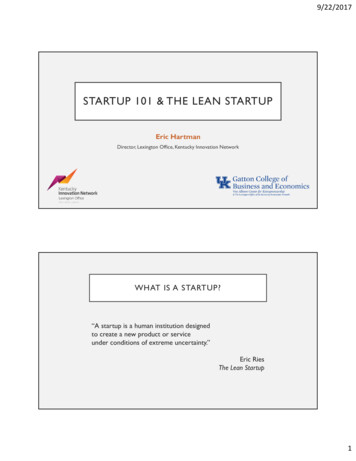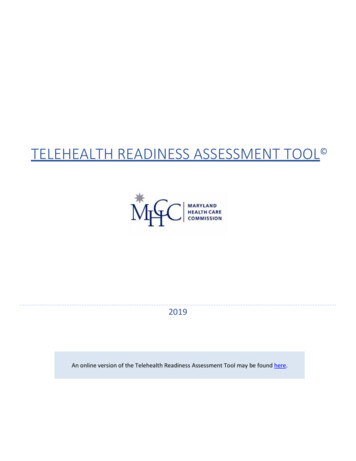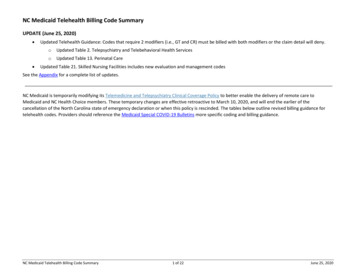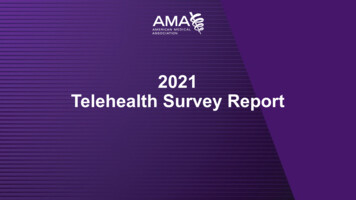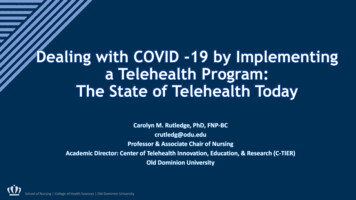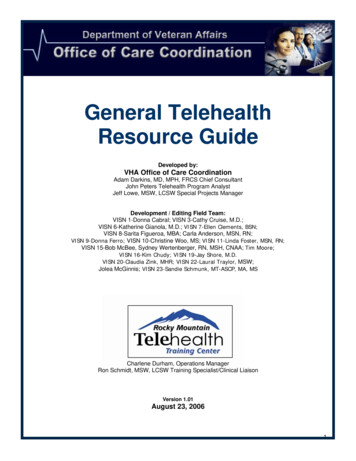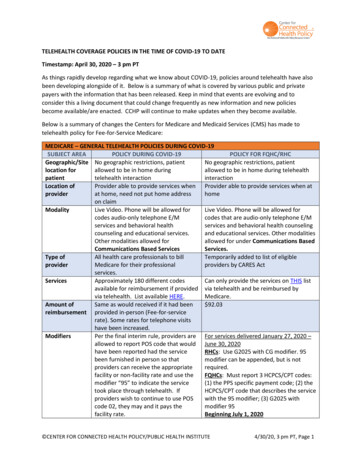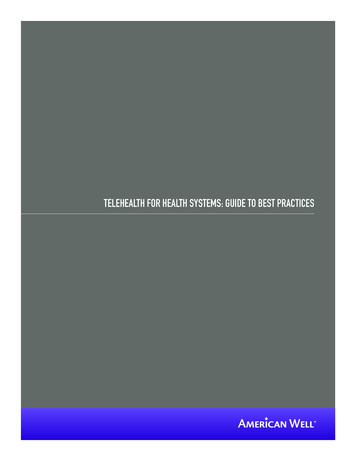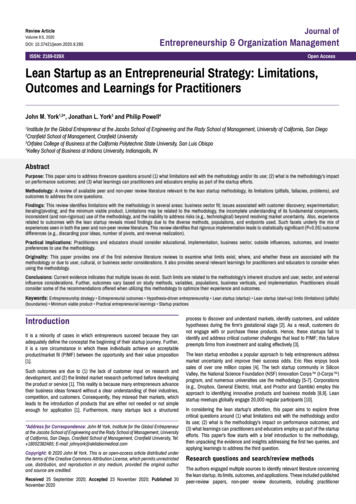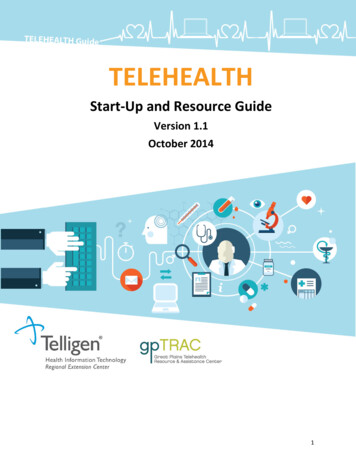
Transcription
TELEHEALTHStart-Up and Resource GuideVersion 1.1October 20141
Table of ContentsIntroduction . 3What is Telehealth? . 4What is Telemedicine? . 4The Dynamics of Telehealth . 5Why Is Telehealth Important? . 6Telehealth Studies of Interest . 6Getting Started. 9What Services Can Be Provided By Telemedicine? . 9Practice Guidelines . 9American Telehealth Association (ATA) Standards & Guidelines . 9The AMA Policy on Telemedicine. 10California Telehealth Resource Center’s Program Developer . 11Telligen Interview Findings with Telehealth Stakeholders August 2014 . 22Toolkits and information for program initiation: . 23From Startup to Sustainability . 27Telehealth Operations Module . 29Telehealth/Telemedicine Product and Service Directory . 30Billing and Reimbursement . 30Telemedicine Reimbursement Guide . 30Medicare Telehealth / Billing . 30CMS Telehealth Code Information. 31Medicaid/Telemedicine . 31Policy Considerations for Telehealth Start-Up . 35What’s On the Horizon for Telehealth . 38Iowa-Specific Resources. 41Examples of Telehealth Projects—Iowa . 42Facility-Specific Telehealth Projects. 42Telehealth Policy Resources - Iowa. 44Key Websites . 44Medically Underserved Areas/Populations (MUAs & MUPs) and Countywide Health ProfessionalShortage Areas (HPSAs) . 46Iowa Resources . 48Resources . 49Resource Listing . 52Regional Telehealth Resource Centers (RTRCs) . 522
IntroductionThis start-up and resource guide was created in partnership between Telligen and gpTRAC, the GreatPlains Telehealth Resource and Assistance Center. It is intended to provide an overview and frameworkfor implementing telehealth in critical access hospitals and rural areas. It is also intended to point thereader to reliable and informative resources for learning about telehealth and the organizations thatsupport the use of telehealth in various ways.With many excellent organizations and resources available, we envisioned this guide as a starting pointand way of directing the reader to the appropriate resource for his/her specific purpose. It could beused as a reference for new efforts, ongoing telehealth programs, or even included in orientation fornew staff. It is the hope of Telligen and gpTRAC that this guide will especially assist those consideringstarting up a telehealth program in their facilities. Substantial research went into the development ofthis guidebook. Numerous resources are highlighted, including the American Telemedicine Association,gpTRAC, the Center for Telehealth and e-Health Law, the California Telehealth Resource Center (CTRC),who we would like to thank for their permission to use many of their toolkits and best practices in thisguide. We would also like to thank staff members interviewed at several facilities in Iowa and Coloradowho helped identify barriers and successes encountered in their journey of implementing telehealth.The following facilities were interviewed: Clarke County Hospital, Osceola, Iowa Yuma District Hospital, Yuma, Colorado Centura Health, Denver, Colorado Colorado Access, Denver, ColoradoThe information and links in this guide are current as of the date of its publication. As with many otherhealth and technology related topics, information and resources are constantly changing and evolving.It is possible that some resources will be updated or moved from the location specified in the linksprovided. However, we expect that most resources can still be located by contacting the organizationassociated with specific resource, should the information associated with the link not appear whenclicked.3
What is Telehealth?Telehealth is the use of digital technologies to deliver medical care, health education, and public healthservices by connecting multiple users in separate locations. Telehealth encompasses a broad definitionof technology-enabled health care services. Telehealth includes telemedicine (diagnosis and treatmentof illness or injury – see detailed description below), and services such as assessment, monitoring,communications, prevention and education. It involves a broad range of telecommunications, healthinformation, videoconferencing, and digital image technologies. The National Consortium of TelehealthResource Centers finalized a Telehealth Definition Framework to help policy makers, practitioners,payers, and the public understand how to accurately discuss “telehealth” and its key components. Theconsortium consists of the twelve federally designated regional centers and two national telehealthresource centers (TRCs).The full definition framework can be found s 0.pdf.What is Telemedicine?The American Telemedicine Association (ATA) defines telemedicine as the use of medical informationexchanged from one site to another via electronic communications to improve a patient’s clinical healthstatus. Telemedicine includes a growing variety of applications and services using two-way video, smartphones, wireless tools and other forms of telecommunications technology. Starting over forty years agowith demonstrations of hospitals extending care to patients in remote areas, the use of telemedicinehas spread rapidly and is now becoming integrated into the ongoing operations of hospitals, specialtydepartments, home health agencies, private physician offices, as well as consumer’s homes andworkplaces.Telemedicine is not a separate medical specialty. Products and services related to telemedicine areoften part of a larger investment by health care institutions in either information technology or thedelivery of clinical care. Even in the reimbursement fee structure, there is usually no distinction madebetween services provided on site and those provided through telemedicine and often no separatecoding required for billing of remote services. ATA has historically considered telemedicine andtelehealth to be interchangeable terms, encompassing a wide definition of remote healthcare. Patientconsultations via video conferencing, transmission of still images, e-health including patient portals,remote monitoring of vital signs, continuing medical education, consumer-focused wireless applicationsand nursing call centers, among other applications, are all considered part of telemedicine andtelehealth.While the term telehealth is sometimes used to refer to a broader definition of remote healthcare thatdoes not always involve clinical services, ATA uses the terms in the same way one would refer tomedicine or health in the common vernacular. Telemedicine is closely allied with the term healthinformation technology (HIT). However, HIT more commonly refers to electronic medical records andrelated information systems while telemedicine refers to the actual delivery of remote clinical servicesusing technology.4
The Dynamics of TelehealthTelehealth clinical services (or telemedicine) are currently delivered in three major ways: Video conferencing, which is used for real-time patient-provider consultations, provider-toprovider discussions, and language translation services. Remote patient monitoring, in which electronic devices transmit patient health information tohealth care providers.Store & forward technologies, which electronically transmit pre-recorded videos and digital images,such as X-rays, video clips and photos, between primary care providers and medical specialists. Moreinformation: http://cchpca.org/what-is-telehealthHealth education can also be delivered in a similar manner and includes a broad range of activities, suchas classes, patient portals and online discussion forums for patients, and training programs for all levelsof health professionals. These services can be live interactive video with multiple users communicatingin real time, or pre-recorded on-demand video streaming that can be downloaded to computers ordigital devices. Public health services include disaster management systems, which can expand thecapacity of local emergency medical providers, and pandemic/epidemic public communicationsactivities.Telehealth technologies can be transmitted a number of different ways.These include: Encrypted Internet connections. Major broadband networks, such as the California Resource Network which provides dedicatedcircuits for network users. These networks deliver secure, private data transmission, explicitquality of service, and prioritization of emergency medical communications. They allow allnetwork users to connect with each other, and to connect with non-network users via the publicInternet. These networks involve large numbers of users, and can be easily expanded toaccommodate new users. High-speed telecommunications lines, which allow dedicated secure connections to other siteswith similar connectivity. Private point-to-point broadband connections, which provide secure transmissions, but unlikebroadband networks, connect specific facilities to one another. Patient monitoring centers, which receive transmissions from at-home and other remotemeasurement devices. Single-line telephone and video lines, which connect providers with patients at home.5
Why Is Telehealth Important?Telehealth technologies can help achieve health care's "triple aim", developed by the Institute forHealthcare Improvement, of improved patient outcomes and access to care, and cost savings to thehealth care system.Telehealth provides valuable tools that can improve health outcomes and access to care, and makehealth care delivery systems more efficient and cost-effective. Telehealth can deliver important medicalservices where they are needed most, and remove barriers of time, distance, and provider scarcities.This includes remote, rural areas and medically underserved urban communities. For example: Since its inception in 2009, eEmergency (a service of Avera eCare, which supports 675 ruralclinicians in the central US, including Iowa, Minnesota, Nebraska, North Dakota, South Dakota)has served more than 15,000 patients at 70 locations through two-way video interaction ortransfer assistance. Because of eEmergency care, 2,001 patients who would have transferredwere able to receive care in their own communities. Transfers avoided because of eEmergencyhave saved more than 15.8 million in transfer costs. http://www.avera.org/ecare/eemergency/ 237,221,884 kilometers (147,402,844.886 miles) of patient travel was avoided by usingTelemedicine per the Ontario Telemedicine Network (OTN) in their 2012-13 Annual l-report-2012-13.pdf The Carolina HealthCare system successfully reduced hospital readmissions for Advanced HeartFailure Patients using basic video conferencing and a peripheral stethoscope as part of theirprogram to ensure patients living far from the hospital, necessitating significant travel forfollow-up. During the 6 month pilot June through December 2013, 60 new patients wereenrolled in the virtual clinic and 165 virtual encounters occurred. The 30-day all causereadmission rate at CMC-L has decreased from 19.39 % in 2010 to 9.82 % in ailure-patients#.VIpVVCvF zgTelehealth Studies of InterestThere are several studies that demonstrate the impact of telehealth. Some of them evaluate the impactof telehealth on lowering healthcare costs while others look at the business case for telehealth. In termsof the clinical impact of telehealth, there are many reports that highlight the clinical benefits ofincreased access to care, which telehealth can provide.Positive OutcomesThe impact of telehealth technologies can be significant for patients and facilities. Here are examples ofimprovements in care and outcomes for patients, made possible through telehealth services: Efficacy of telemedicine for stroke- http://www.ncbi.nlm.nih.gov/pubmed/224009706
Beacon trial reduced readmissions of heart patients to 3% using home video conferences- conferences/ A Multicenter Study of ICU Telemedicine Reengineering of Adult Critical Care- spx?articleid 1788059 Impact of Tele-ICU on Patient Outcomes- pact of TeleICU on Patient Outcomes.pdf Comparing Virtual to Traditional Consults- -12-65.pdf Effects of Telepsychiatry on the Doctor-Patient Relationship- on-satisfaction-and-relevant-issues/ Increasing Access to Chronic Disease Self-Management Programs in Rural and RemoteCommunities Using Telehealth- mj.2012.0197 Patient Story - Video (CTeL)- http://player.vimeo.com/video/41772681 School-based Telehealth Program Summary- : The inclusion of these links does not imply endorsement or recommendation ofthese products/services. These are being shared as examples of successful telehealthprograms/services.Other Studies: Cost-Effectiveness of Hub-and-Spoke Telestroke Networks for the Management of AcuteIschemic Stroke From the Hospitals’ Perspectives- Deloitte: Global eVisits to reach 100 million by year’s end (from FierceHealthIT, 8/12/14)- sits: the 21st century house call- 2012/12/04/CIRCOUTCOMES.112.967125.abstract?sid ction-evisits.pdfThe case for tele-emergency services: New research finds promise in tele-emergency system’sability to improve patient ncy-services7
The Promise of Connected Care in the United States- TeleStroke Units Serving as a Model of Care in Rural Areas: 10-Year Experience of theTeleMedical Project for Integrative Stroke Care- /08/12/337343.htmTelemedicine in primary-care- /201408120011The Promise of Telemedicine to Pare Health Costs- icine gives patients an alternative- /365435/Extent of Telehealth Use in Rural and Urban Hospitals, April .pdf8
Getting StartedWhat Services Can Be Provided By Telemedicine?Sometimes telemedicine is best understood in terms of the services provided and the mechanisms usedto provide those services. Here are some examples. Keep in mind that this list grows annually: Primary care and specialist referral services may involve a primary care or allied healthprofessional providing a consultation with a patient or a specialist assisting the primary carephysician in rendering a diagnosis. This may involve the use of live interactive video or the use ofstore and forward transmission of diagnostic images, vital signs and/or video clips along withpatient data for later review. Remote patient monitoring, including home telehealth, uses devices to remotely collect andsend data to a home health agency or a remote diagnostic testing facility (RDTF) forinterpretation. Such applications might include a specific vital sign, such as blood glucose orheart ECG or a variety of indicators for homebound patients. Such services can be used tosupplement the use of visiting nurses. Consumer medical and health information includes the use of the Internet and wireless devicesfor consumers to obtain specialized health information and on-line discussion groups to providepeer-to-peer support. Medical education provides continuing medical education credits for health professionals andspecial medical education seminars for targeted groups in remote locations.Practice GuidelinesIt is important to view telehealth/telemedicine services in a manner similar to those provided in-person.It is a tool in the provision of quality care. The focus should always remain on how this will affect/benefitthe patient. It is important not to impact the provider’s practice in a negative manner. Telehealth shouldbe smoothly incorporated, looking to the various standards, guidelines and professional practicepolicies.American Telehealth Association (ATA) Standards & GuidelinesATA has a number of practice guidelines for telemedicine which provide a critical foundation for thedeployment of telemedicine services. Standards form the basis for uniform, quality patient care andsafety, grounded in empirical research and clinical experience. The establishment of such standards alsoaccelerates the adoption of telemedicine by payers, administrators and providers who are full partnerswith ATA in their development along with industry, government agencies, medical societies and otherstakeholders.The ATA website gives you access to a plethora of resources including standards, guidelines, learningcenter, telemedicine buyer’s guide, liability insurance, videos and the latest news in telemedicine. It isfree to register and log on to their on-demand learning center.You can access it here: http://www.americantelemed.org/home9
(The following was posted by: Jonathan Neufeld, PhD, HSPP, Clinical Director of the Upper MidwestTelehealth Resource Center, on Tuesday, July 22, 2014.)The AMA Policy on TelemedicineIn June 2014, the American Medical Association released a policy report outlining its stance on therapidly evolving world of telemedicine and remote care. The report, developed by the AMA’s Council onMedical Service, affirms the AMA’s previous stance that all types of medical services should be fairlycompensated, whether delivered in person, by phone, or electronically. The report also addresses theestablishment of practice guidelines and mentions existing position papers and case studies. The reportcan be accessed on the AMA’s web site: ine.page (You will need a user name and passwordto access.)The report provides the following summary of its position regarding telemedicine services:Prior to delivering services via telemedicine, the Council believes a valid patient-physician relationshipmust be established, through at minimum a face-to-face examination, if a face-to-face encounter wouldotherwise be required in the provision of the same service not delivered via telemedicine. The face-to-faceencounter could occur in person or virtually through real-time audio and video technology. Also, before atelemedicine service is provided, the physician or other health professional must notify the patient of costsharing responsibilities and limitations in drugs that can be prescribed via telemedicine. When a service isdelivered using telemedicine, mechanisms to ensure continuity of care, follow-up care and referrals foremergency services must be in place.At first, the paragraph seems to imply that an in-person examination is being required in order toestablish a valid patient-physician relationship. This has been the traditional meaning of the term “faceto-face.” Reading further in the statement, however, one finds that the AMA has joined the growingconsensus among healthcare providers in finding that a “face-to-face encounter could occur in person orvirtually through real time audio and video technology.The Federation of State Medical Boards (FSMB) recently took the same position in its recommendationsregarding state board regulation of /FSMB/Advocacy/FSMB Telemedicine Policy.pdfThese statements and others point to a sea change in how telemedicine is being conceptualized byregulators and other stakeholders. Though valid concerns remain about the appropriate application ofvarious telehealth/telemedicine modalities, there can be no doubt that a growing consensus exists tosupport the idea that a properly conducted “virtual” examination can be entirely adequate to establish avalid patient-physician (or any “-clinician”) relationship and support the provision of high quality,standards-compliant care for a wide variety of conditions and in a wide range of circumstances.This change is likely to continue to the point that virtual care becomes commonplace, and we no longerask if telemedicine is appropriate for this or that particular case, but rather provide both in-person andtelemedicine modalities among our first-line treatments in many common situations.(End post)10
The following section has been adapted with permission from the California Telehealth ResourceCenter’s (CRTC) Program Developer resource and serves as a summary of that document. It is acompendium of best practices developed from CTRC’s 10 year experience developing telehealthprograms and added to by a panel of telehealth experts from across the country.California Telehealth Resource Center’s Program DeveloperStep One: Needs Analysis & Environmental AnalysisBest Practice: Assess and confirm your organizations readiness for telehealth.It is costly, time consuming and challenging to start a telehealth program even though it may soundeasy. Organizations that perform a formal assessment of readiness have the advantage of identifyingpotential problems and addressing them early. They also gain a lot of support for the project byengaging people early.Lessons from the field Be sure the program “matches the mission/vision”. Buying equipment is not the first step. You need the proper authority to successfully move forward. Knowing and reporting the strengths, weaknesses, opportunities and threats (SWOT) of yourorganization will help build the case for your program. Bringing the major department heads into the process early allows for easier development andacceptance of the program. Identify appropriate leadership team members, and bring the team together early.Best Practice: Perform A Needs AnalysisA needs analysis will help your organization to identify key unmet needs and will help you deviseeffective strategies and approaches to meet them. It will give you a clear understanding of the natureand scope of the unmet need, provide a sound foundation for planning, help you clarify objectives andshared expectations, improve coordination of services and resources and provide supporting structurefor your program evaluation.Lessons from the field Determine the needs you wish to meet, and how you are going to meet them. Invite clinical staffto identify service needs at both host and remote sites at patient and provider sites. Ensure the needs analysis is data driven. Recognize that the needs analysis is inseparable from the program model and the business case.It lies at the heart of sound telehealth program planning.Step Two: Define Services, Program Model and Technology ModelsResearch should be done prior to program model development, pertaining to the technologicalcapabilities and costs of acquiring and maintaining the resources. You could face problems whenresources that do not allow for optimal technology and the program is reduced or implemented at lower11
quality as a result. What elements can be sacrificed if necessary? Prioritize components of the programby essential, would be helpful, and not necessary.Have a clear understanding of the types of services you wish to deliver and the best and mostappropriate telehealth program model for your particular organization. Identify which services you willtarget, which geographical regions you will serve, what form of telehealth modalities you willimplement.Best Practice: Develop preliminary goals and objects for service deliveryMeasurable goals and objectives will assist in selecting equipment, developing staffing, evaluatingperformance, creating cost estimates in every facet of program design and development.Lessons from the field . Prioritize your service options. Be mindful of the size and scale of the program you are creating. Stay focused on the success ofyour initial few sites. Start small to help guarantee success. Expect that technological capabilities and workflow will vary across sites and try to anticipatehow to adapt to these differences.Best Practice: Assure that the selected delivery model best suits your service goals and objectives Understand the various forms of telehealth currently in use and ensure your choice is suited tothe particular specialty services you plan to provide. Familiarize yourself with the different types of telehealth and select the right kind(s) for yourparticular practice. A system that contains elements of each, can prove highly effective,particularly in the delivery of multi-disciplinary care. Create high quality, structured and layered training, and plan to provide it on an ongoing basis,at both host and remote sites.Keep your model in line with your organization’s vision, mission and strategic plan.Best Practice: Plan to incorporate Health Information Technology (HIT)The implementation of electronic medical records and other HIT is taking place at a rapid rate.Telehealth systems should be designed and structured to support health information exchange.Lessons from the field If your organization is not currently deploying HIT methods and practices, it soon will beexpected to at some level. Be mindful of this. There are always serious network security and privacy issues and concerns related to HIT, so it isimperative your technical leadership and legal counsel are involved in this planning from theoutset. Substantial seed funding opportunities are increasingly available to support HIT deployment andintegration, often focused on the establishment of high speed (T1 and above) networkinfrastructure. This same network can f
services by connecting multiple users in separate locations. Telehealth encompasses a broad definition of technology-enabled health care services. Telehealth includes telemedicine (diagnosis and treatment of illness or injury - see detailed description below), and services such as assessment, monitoring, communications, prevention and education.
